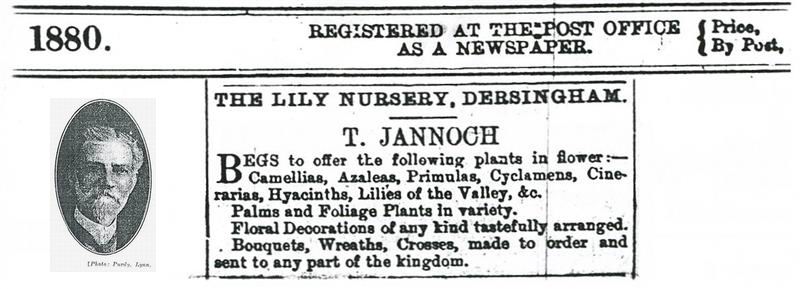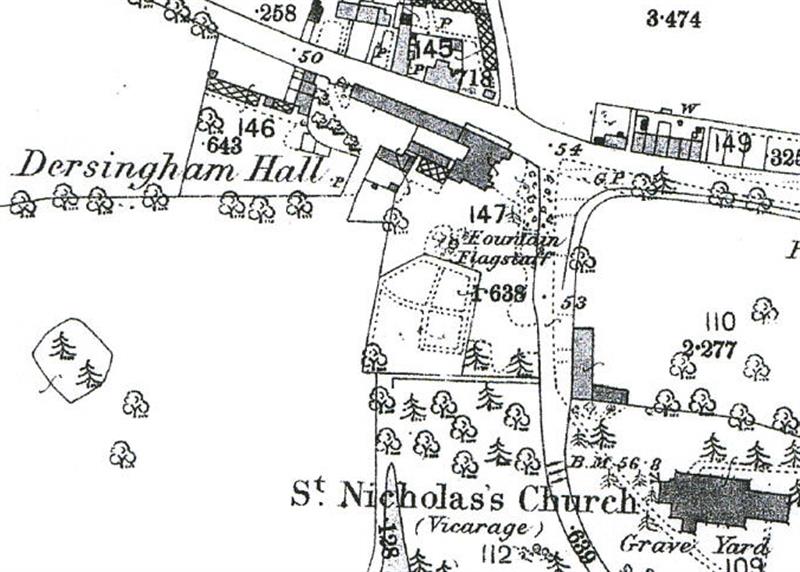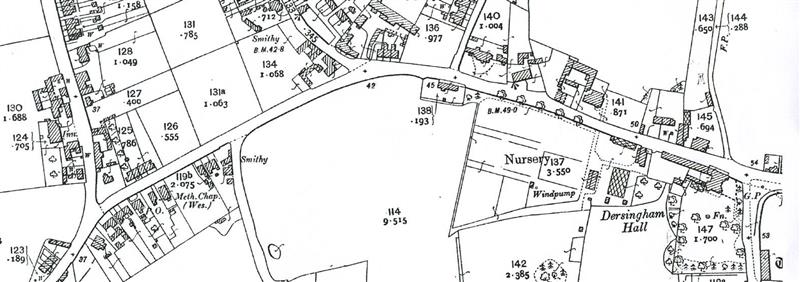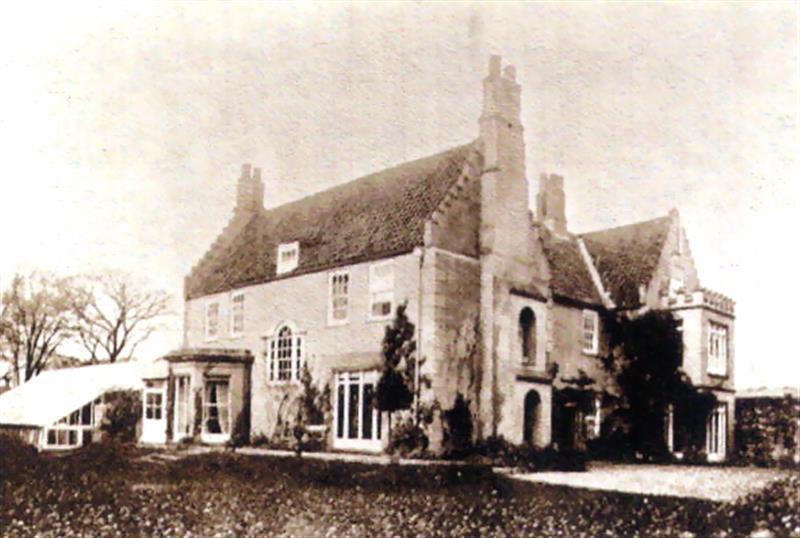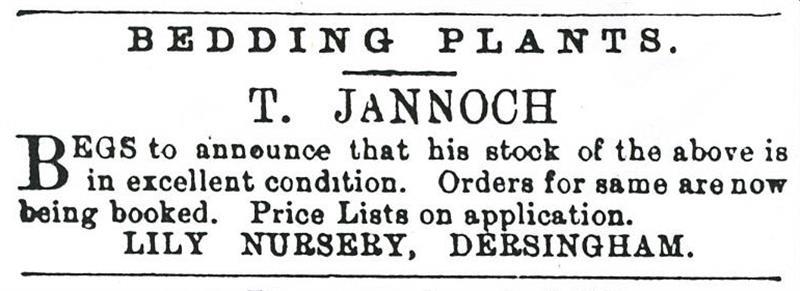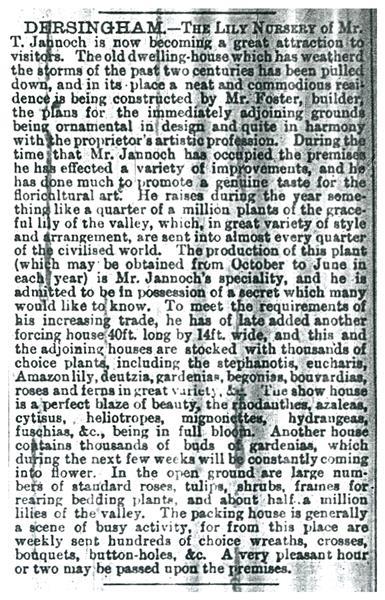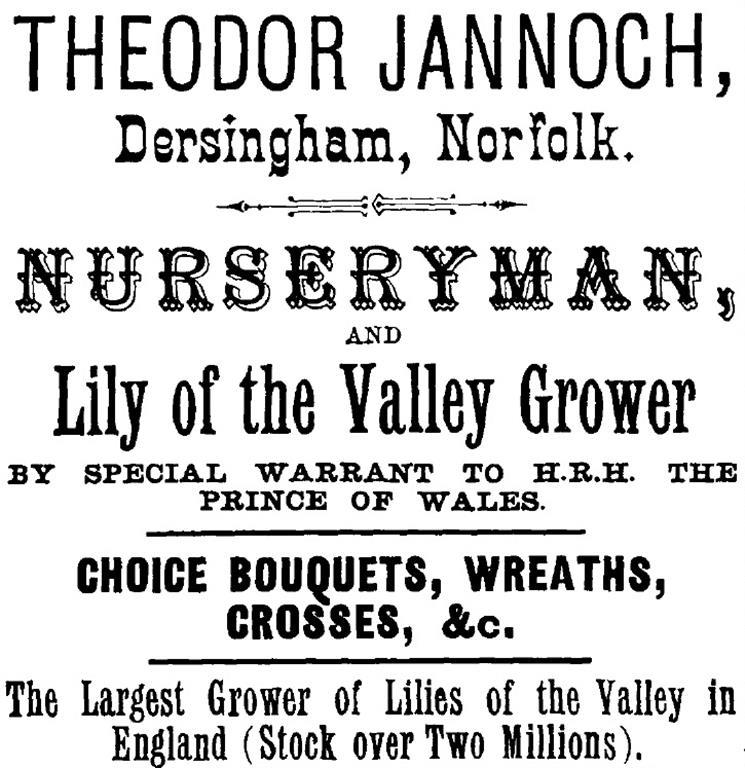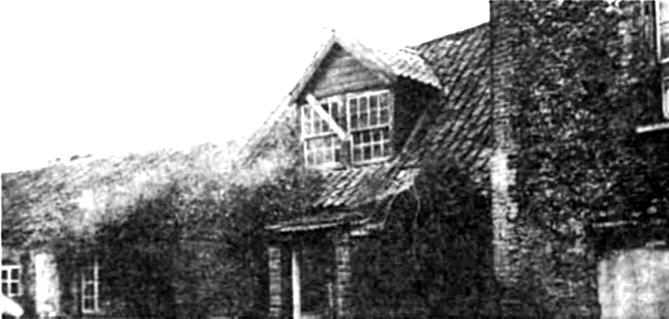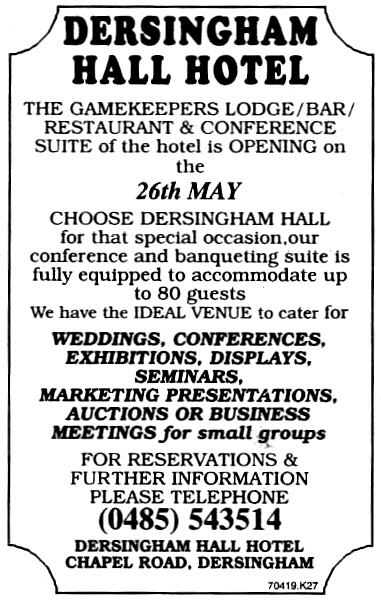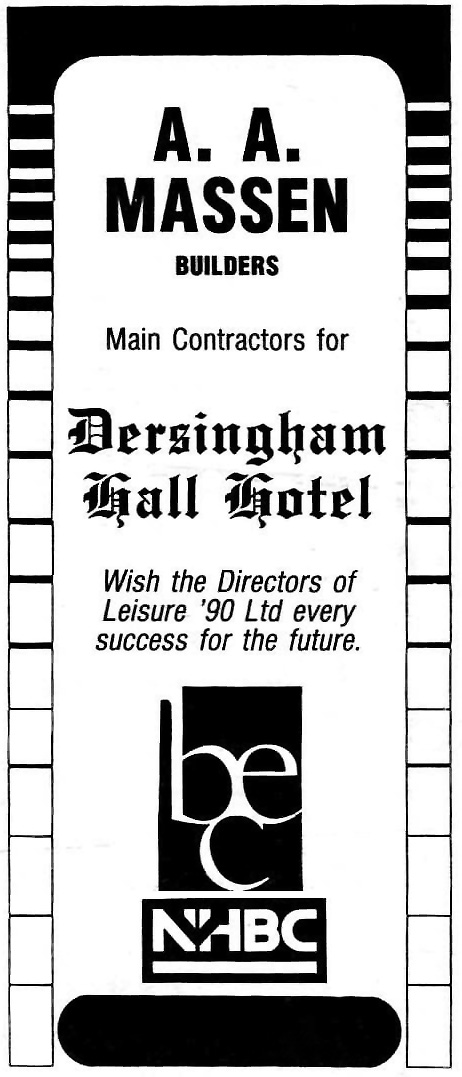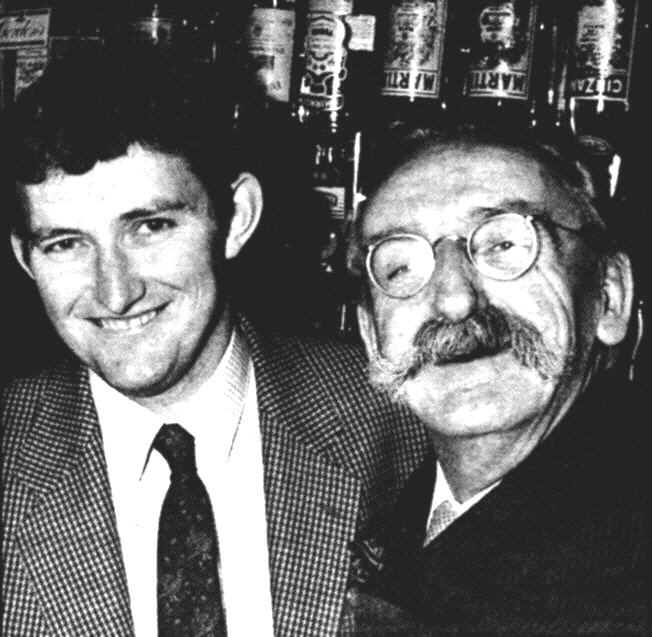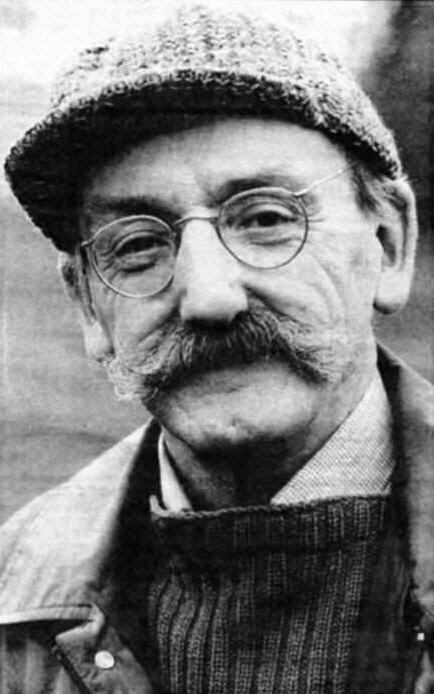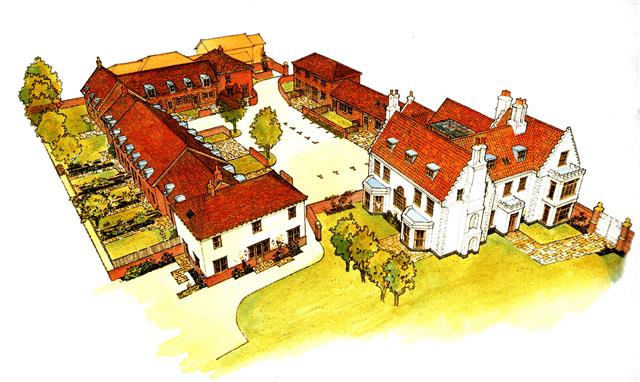The following report copied out of the newspaper reveals that not long after moving here he had demolished the original cottage to build this smart new house. It also paints a vivid picture of the thriving business he ran from this site.
Report from The Lynn News and Advertiser May 1884
DERSINGHAM. The lily nursery of Mr. T. Jannoch is now becoming a great attraction to visitors. The old dwelling-house which has weathered the storms of the past two centuries has been pulled down and in its place a neat and commodious residence is being constructed by Mr. Foster, builder, the plans for the immediately adjoining grounds being ornamental in design and quite in harmony with the proprietor's artistic profession. During the time that Mr. Jannoch has occupied the premises he has effected a variety of improvements and he has done much to promote a genuine taste for the floricultural art. He raises during the year something like a quarter of a million plants of the graceful lily of the valley which, in great variety of style and arrangement are sent to almost every quarter of the civilised world. The production of this plant (which may be obtained from October to June in each year) is Mr. Jannoch's speciality and he is admitted to be in possession of a secret which many would like to know. To meet the requirements of his increasing trade he has of late added another forcing house, 40ft. Long and 14ft. Wide and this and the adjoining houses are stocked with thousands of choice plants, including stephanotis, eucharis, Amazon lily, deutzia, gardenias, begonias, bouvardias, roses and ferns in great variety. The show house is a perfect blaze of beauty, the rhodanthes, azaleas, cystisus, heliotropes, mignonettes, hydrangeas, fuschias, etc. being in full bloom. Another house contains thousands of buds of gardenias which during the next few weeks will be constantly coming into flower. In the open grounds are large numbers of standard roses, tulips, shrubs, frames for rearing bedding plants and about half a million lilies of the valley. The packing house is generally a scene of busy activity as from this place are weekly sent hundreds of choice wreaths, crosses, bouquets, buttonholes etc. A very pleasant hour or two may be passed upon the premises.
The village when Theodor and Mary arrived here had a population of just over 1000. It was smaller than today with much more pasture land and marsh. Across the road from the nursery Dersingham Hall was occupied by John and Hannah Goggs and their nine children.
The church, which had become very dilapidated over the years, had been restored at a cost of £5000 and an imposing new Rectory had just been completed on the high ground above the church. The Reverend Edward William Penney had taken up residence there and had no doubt welcomed Theodor and his family to the village. The Methodist Chapel close to The Feathers had been built and the Bethel chapel in Chapel Road was completed shortly after the family's arrival.
A new village school had also been built at the bottom of Dodds Hill and Alfred Firth had been appointed Head Teacher. He was living in the School House which would seem to have been that part of the school building on the corner of Dodd's Hill.
A few doors away from Brandenburg House Enoch Beckett the Post Master ran his Post Office, grocery and Drapers in the long cottage at the end of King's Croft. Joshua Freeman was living with his wife Susan and two daughters at the Manor House and farming 1300 acres.
The railway of course was well established and Matthew Bullock was the station master who supervised the frequent services to Lynn and Hunstanton. Theodor and his wife could also have travelled directly into London and there were frequent special excursions. In 1875 one was advertised at the cost of 12 shillings First Class or 6shillings in a Covered car. The train left at 6a.m. and reached London Bishopsgate at 10.10 a.m. It returned the following day at 5.30p.m. but no luggage was allowed apart from a small bag carried by the owner. There were (six) Public Houses in the village; The Dun Cow, The Cock , The White Horse, The Coach and Horses, and the Albert Victor.
Also high above the village the last remaining windmill was operated by Matthew Fitt the Master Baker and Corn Miller. The village was quite self sufficient with butchers, grocers, bakers, coal merchants, shoe makers, carpenters, builders, tailors, dressmakers and if you so wished Elizabeth Wyer would make you a straw bonnet. There were several farms both large and small with all the trades associated with an agricultural community, wheelwrights, hurdlemakers, blacksmiths and so on. Theodor's nursery would fit into the village pattern extremely well.
Over the next few years Theodor worked to establish his nursery business and soon adverts were appearing in the local press.
In 1880 from The Lily Nursery Dersingham T. Jannoch begged,"to announce that his stock of bedding plants is in excellent condition. Orders for the same are now being booked." Another advert that same year advised that he had Camellias, Azaleas, primulas, cinerarias, Hyacinths and Lily- the- valley for sale along with Palms and Foliage plants of all kinds. Furthermore floral work of any description would be carried out in, "the most artistic designs". Bouquets, wreaths and crosses would be made to order and sent to any part of the kingdom and Hotels could be supplied with plants and flowers on the hire system. The business was clearly flourishing and Theodor took another significant step on July 30th 1880 when he became a naturalised English citizen.
Theodor and Mary's family also grew steadily. Hedwig Theodora, usually known as Dora, their second child was born in 1876, and her sister Alwine Franziska, known as Vena, followed in 1878. But they had their fair share of heart break. Bertha Wilhelmina born in 1880 died just one year later. Their first son , Fritz Wilhelm, was born that same year of 1881 but only lived a few months dying in 1882. Another daughter, Flora Antoinette, born in 1883 lived just six years. When Rudoph Theodore was born in 1885 they must have been very anxious during his early years but Rudolph live well into the 20th century dying aged 75 in 1960.
While at Kew, Theodor was regarded as one of the pioneers in the application of the "retarding" principle to many plants but at Dersingham he also became interested in experiments that would produce the opposite effect by subjecting plants to the influence of ether. . In the biographical details about Theodor recorded in The Kew Guild Journal of 1926 it states that he "founded a somewhat unique business at Dersingham, in the county of Norfolk, devoted almost entirely to the cultivation of Lily of the Valley and Lilacs. He was regarded as one of the pioneers in the application of the retarding principle to many forms of plant life and for a considerable time he interested himself in experiments intended to produce the reverse effect by subjecting the plants to ether. For many years the collections of lilacs in his nurseries was regarded as the finest in England." King Edward VII was a frequent visitor to the nursery.
He also began to specialise in the growing of Lily-of-the-valley and soon proclaimed that he was the largest grower of those plants in England with a stock of over two million. Someone who took a keen interest in his experiments and frequently visited the nursery was The Prince of Wales. On his accession to the throne as King Edward V11 he still maintained his interest so that Theodor advertised that he was "nurseryman, florist and Lily-of-the -valley grower by special warrant to their Majesties The King and Queen Alexandra. "Christmas Day 1909 was the last time the King visited the nursery before his death the following year.
As the twentieth century dawned Theodor's business was thriving. His family were grown up and we learn that his youngest daughter Vena had inherited her father's artistic abilities as the parish magazine reported that she had received the honour of having a picture hung at the Royal Academy of Arts. The year after this Dersingham Hall had become vacant and Theodor had obviously bought it and was advertising it to let furnished. However it was not long before he had moved his family to The Hall and set up his nursery on the land which is now the Old Hall Estate. (By 1908 Brandenburg House was occupied by James La Fontaine J.P. and the property called Mecklenburg House was owned by Thomas Diggle. The house presently known by that name was built around this time or a little later and there is evidence that it replaced the original old cottages that stood on that site when Theodor was there).
There was a significant change in the 1901 census where Theodor was now recorded as a Naturalized English Subject although he had in fact acquired that status in July 1880 as has been stated. He took a full and active part in village life. He donated generously towards the fund for the Clock to be placed in the Church Tower to mark the 1901 coronation as well as making regular donations to the cricket club. He was active in the Sandringham Estate Cottage Horticultural Society and in 1911 he was one of the first names put forward to serve on the committee to consider all the suggestions for marking the coronation of King George V. He was on the committee of the newly built Working Men's Club and gave many floral arrangements to decorate both that Hall and the Church Institute when they were formally opened.
He was a member of the Royal Horticultural Society and regularly exhibited at that Society's Spring Show in London where he won both gold and silver medals. The Royal Botanic Gardens in Kew have many entries in their records of the plants that he sent there. By 1911 his son Rudolf was living in London and working in Islington as a Clerk in a Marine Insurance Office.
The years 1914 to 1918 must have been a difficult and uncomfortable time for Theodor as the war with Germany was fought. It was after all between his adopted country and the land of his birth. The papers were full of anti- German rhetoric and reports of attacks on businesses with German sounding names filled the local press. There was special unease about aliens in Norfolk because of the closeness of the North Sea. In August 1914 the Alien Registration Act was published and all Germans had to register with the authorities by August 17th. Aliens had to have a permit if travelling more than five miles from their registered place of residence and they had to carry an identity document.
In a letter to the local press The Chief Constable reported there were just 4 German males in the county. One was a pauper in the workhouse and the other 3 were found to be perfectly harmless after thorough investigation. One of these I assume must have been Theodor.
Nevertheless it must have been an uneasy time for him especially when in January1915 the Zeppelin L4 flew over the village and went on to cause death and destruction in Lynn (Village Voice No.38) Then the following year another Zeppelin L21, part of the largest Zeppelin raid during the night of 2/3rd September, damaged a cottage up Doddshill and killed the lady living there. I have not found any evidence that Theodor experienced any difficulties at this time. His son Rudolf served with the Middlesex Regiment from 1914 - 1920.
After the war he and his family continued to be held in high regard. By this time Theodor had largely retired from active business and in his final years he devoted his attention to raising new varieties of Lilacs. His collection was considered to be the finest in the country. He had just developed a lilac of primrose hue when he was confined to his room in poor health so it was not introduced to the public. After just six weeks illness he died on October 29th 1925. His wife Mary, who was described as a strong vigorous personality, lived on at the Hall cared for by her daughter Dora until she died in 1933and was laid to rest next to her husband.
Theodor's nursery has disappeared beneath the houses of the Old Hall Estate but his home Dersingham Hall now bears the name Jannoch's Court and on the opposite side of the road the property there still carries the name Mecklenburg House. Older villagers used to call the road by the church Jannoch's corner and I can remember the woods where Croft House now stands being full of snowdrops and lily-of-the-valley and perhaps somewhere that pale yellow lilac still flowers.


